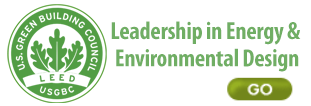.svg)
Spotlight
.svg)
Informations sur LEED

Ces informations ne sont pas mises à jour. Pour les informations les plus récentes concernant cette norme, veuillez consulter https://www.usgbc.org/leed.
LEED, qui signifie Leadership in Energy and Environmental Design, est un ensemble de directives relatives aux projets de construction publiées par le U.S. Green Building Council et constitue aujourd'hui le système d'évaluation des bâtiments écologiques le plus utilisé au monde. LEED fournit un cadre de durabilité pour la conception, la construction, l'exploitation et la maintenance des bâtiments nouveaux et existants. En utilisant un système de notation qui encourage et récompense la conception et les performances durables, le programme motive les professionnels de l'industrie à identifier et à mettre en œuvre des solutions vertes pour réduire les impacts environnementaux et donner la priorité aux pratiques durables qui profitent aux communautés existantes et futures.
Le programme LEED se concentre principalement sur les adhésifs lorsqu'il s'agit de prendre en compte la qualité de l'air intérieur dans les projets de construction écologique. Les crédits relatifs aux matériaux à faibles émissions sont obtenus lorsque les produits de construction et les meubles démontrent leur capacité à répondre aux exigences en matière d'émissions de composés organiques volatils (COV) et de teneur en composés organiques volatils (COV). Les produits en bois composite doivent utiliser des résines ULEF ou NAF telles que définies et certifiées selon la norme CARB Airborne Toxic Control Measure (ATCM) ou TSCA Title VI.
Les systèmes de notation et les directives LEED peuvent être téléchargés à l'adresse www.usgbc.org.
Produits adhésifs Franklin
Le tableau LEED ci-dessous illustre nos adhésifs qui répondent aux exigences actuelles en matière de matériaux LEED à faibles émissions décrites plus haut dans cette brochure.
Ensuite, le deuxième tableau répertorie un échantillon de nos adhésifs et leur conformité aux normes TSCA Title VI et aux normes européennes sur le formaldéhyde. Ce tableau sert uniquement de guide car le titre VI de la TSCA et d'autres réglementations internationales obligent le fabricant de bois composite à effectuer des tests tiers sur votre support avec l'adhésif que vous utilisez, afin de prouver la conformité à une réglementation particulière.

Si vous souhaitez obtenir des conseils supplémentaires sur l'utilisation de nos produits pour répondre aux normes LEED ou des informations supplémentaires sur les tests, n'hésitez pas à nous contacter au 1.614.443.0241.
Cette brochure a été imprimée à partir des informations les plus récentes disponibles à l'époque. Veuillez vous référer aux directives TSCA Title VI et LEED en vigueur pour une précision totale.
Corporate Contact
Audrey L. Albright
Technical Marketing Specialist
E: audreyalbright@franklininternational.com
T: 1.800.877.4583
Corporate Contact
Audrey Albright
Technical Marketing Specialist
E: audreyalbright@franklininternational.com
T: 1.800.877.4583
Related Products
PVA réticulé
Doorbond 200
PVA réticulé
Multibond 2015
PVA réticulé
Laminating 460
PVA réticulé
Multibond MX-90
More information is available about our complete product offerings. Our experts can recommend specific solutions for your needs.



.svg)
.svg)


.svg)